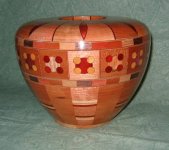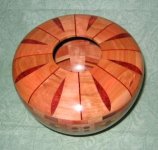Mike Stafford
Member
- Messages
- 2,353
- Location
- Coastal plain of North Carolina
Charles' Bon Bon jar brings to mind a back in the day for me. I used to do segmented staved bowls frequently. I had access to some thick stock that was 1 1/2" to nearly 3" thick. I bought this material in bundles from a specialty millwork shop. They would not use the cut offs from the large boards they used to make doors, moldings etc. They would bundle this up with pallet shrink wrap and sell the bundles for $5 each.
I would use this thick material and make compound mitered bowl blanks. People said they would not stay together glued in the manner I used to make these blanks/bowls. Almost 20 years later they are still together just fine.
Here are a couple that I made. These are old pictures so be gentle.
.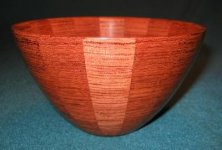
 This is bubinga and the board were 6/4 stock.
This is bubinga and the board were 6/4 stock.
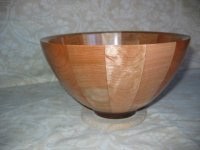
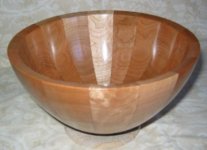 This is maple with a walnut foot. Made from 10/4 stock.
This is maple with a walnut foot. Made from 10/4 stock.
These were glued together with polyurethane glue.
I would use this thick material and make compound mitered bowl blanks. People said they would not stay together glued in the manner I used to make these blanks/bowls. Almost 20 years later they are still together just fine.
Here are a couple that I made. These are old pictures so be gentle.
.

 This is bubinga and the board were 6/4 stock.
This is bubinga and the board were 6/4 stock.
 This is maple with a walnut foot. Made from 10/4 stock.
This is maple with a walnut foot. Made from 10/4 stock.These were glued together with polyurethane glue.


